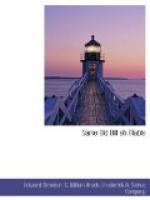“That once famous Dissertation can now be considered only a notable feat of literary card-building; more remarkable for the skill and ingenuity of its construction than for its architectural correctness, strength and durability, or practical usefulness. That the language of the Scottish Lowlands is in all important particulars the same as that of the northern counties of England, will be evident to any unbiassed reader who takes the trouble to compare the Scottish Dictionary with the Glossaries of Brockett, Atkinson, and Peacock. And the similarity is attested in another way by the simple but important fact, that regarding some of our Northern Metrical Romances it is still disputed whether they were composed to the north or the south of the Tweed.... And to this conclusion all competent scholars have given their consent.”
For those who really understand the situation there is no harm in accepting the distinction between “Scottish” and “English,” as explained above. Hence it is that the name of “Middle Scots” has been suggested for “the literary language of Scotland written between the latter half of the fifteenth century and the early decades of the seventeenth.” Most of this literature is highly interesting, at any rate much more so than the “English” literature of the same period, as has been repeatedly remarked. Indeed, this is so well known that special examples are needless; I content myself with referring to the Specimens of Middle Scots, by G. Gregory Smith, Edinburgh and London, 1902. These specimens include extracts from such famous authors as Henryson, Dunbar, Gawain (or Gavin) Douglas, Sir David Lyndesay, John Knox, and George Buchanan. Perhaps it is well to add that “Scottis” or “Scots” is the Northern form of “Scottish” or “Scotch”; just as “Inglis” is the Northern form of “English.”
“Middle Scots” implies both “Old Scots” and “Modern Scots.” “Old Scots” is, of course, the same thing as Northumbrian or Northern English of the Middle English Period, which may be roughly dated as extant from 1300 to 1400 or 1450. “Modern Scots” is the dialect (when they employ dialect) illustrated by Allan Ramsay, Alexander Ross, Robert Tannahill, John Galt, James Hogg (the Ettrick Shepherd), Robert Burns, Sir Walter Scott, and very many others.
I conclude this chapter with a characteristic example of Middle Scots. The following well-known passage is from the conclusion to Dunbar’s Golden Targe.
And as I did awake of my sweving{1},
The ioyfull birdis merily did syng
For myrth of Phebus tendir
bem{e}s schene{2};
Swete war the vapouris, soft the morowing{3},
Halesum the vale, depaynt wyth flouris
ying{4};
The air attemperit, sobir,
and amene{5};
In quhite and rede was all
the feld besene{6}
Throu Naturis nobil fresch anamalyng{7},
In mirthfull May, of eviry
moneth Quene.




